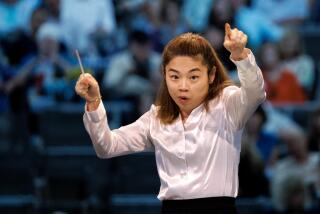WEEKEND REVIEWS : Music : A Businesslike Walter Mitty Conducts Mahler at the Bowl
The hills are alive with the sound of hype. Never mind. The unlikely story of Gilbert Kaplan requires no gushing embellishment.
Kaplan is many things--successful financier, publisher, investment adviser and editor, for starters. He also happens to be an impractical idealist and brave dreamer. Perhaps most important, he puts his money where his heart sticks.
Other businessmen content themselves with private flights of fantasy-fulfillment. Kaplan flies in public.
Friday night he did it in the vast open spaces of Hollywood Bowl. He conducted--yes, conducted--Mahler’s mighty, sprawling, massively complex and awfully forbidding Symphony No. 2, a.k.a. “Resurrection.” He has been doing it, sporadically, since 1983, when he hired the American Symphony for a New York benefit.
He did it on this festive occasion--unpaid as usual--with two stellar soloists, the splendid Los Angeles Master Chorale and the Los Angeles Philharmonic in full formidable force. Walter Mitty is alive and well at Cahuenga Pass.
This, by the way, wasn’t an ordinary garden-variety concert. It literally marked Mahler’s 135th birthday and, though a few months early, celebrated the 100th anniversary of the first performance of the Second. Fools, one might argue, rush in where Salonens fear to tread.
Mahler has been a major obsession in Kaplan’s life. That’s an understatement. The professorial would-be maestro has lectured extensively on the composer, contributed a good deal of scholarly writing to international musicology and, in some ways most striking, assembled and edited “The Mahler Album”--an unprecedented, exhaustive, brilliant and beautiful collection of historical photographs.
Until Friday, Kaplan’s podium repertory involved only the Second Symphony and the Adagietto from the Fifth. Now we can add the “Star-Spangled Banner” to the list.
Kaplan conducted the anthem earnestly and with brisk precision. He conducted Mahler that way too.
Make no mistake. This man knows the score. He has studied it with long, loving, probing care.
He takes every annotation seriously. He measures his tempos with strict fidelity. He allows no ego indulgences in matters of interpretation. He musters a more-than-reasonable facsimile of technical control. He may be an amateur, but he is no charlatan.
*
Still, the ultimate question nags. Should he be conducting a work like this in a place like this?
If the listener demands little beyond a neat performance--that is, a performance in which the right notes emerge in the right context and the right order--no problem. Problems arise only if the listener wants more.
Kaplan stands before the orchestra and beats time. Tirelessly. The left hand knows what the right hand is doing, and often does the same.
Nothing goes wrong. The symphony unfolds correctly.
It also unfolds stiffly, with mechanical objectivity. One waits in vain for an illuminating overview, for individual touches, for the uplifting jolt of a personal vision. There is little room in Kaplan’s limited scheme for subtle nuance, for elasticity of phrasing, for expressive gestures or dramatic expansion.
The emotional narrative remains square, the dynamic scale flat. The external plan emerges with clean definition, but the inherent stimulation, spiritual as well as sensual, is neglected.
Kaplan steadfastly avoids the self-serving excesses favored by certain glamour-maestros who are more interested in conducting the audience than the music. That’s fine. Still, a Mahlerian who shatters no earth in the ultimate climax deprives the composer and his audience of an essential catharsis.
There is a paradox here. Kaplan performs with staggering modesty. His willingness to perform, on the other hand, is anything but modest.
*
The Philharmonic played superbly, with first-desk players on duty at every crucial chair. It is difficult to gauge, of course, whether the dauntlessly professional followers played superbly because of--or in spite of--their leader.
Ruby Hinds sang the muted “Urlicht” with extraordinary suavity and sensitivity. Gwendolyn Bradley sounded ethereal, vibrato notwithstanding, in the higher solos. The Master Chorale, trained by Paul Salomunovich, did its estimable best to cap the finale with resonant glory.
The new speaker towers projected the orchestral timbres with surprising mellowness. The system proved less kind, however, to the singers, the soprano’s microphone automatically overpowering the mezzo’s.
The official attendance figure for this non-subscription “preseason” event was 6,027, about a third of the Bowl’s total capacity. Philharmonic officials preferred not to speculate as to how many of the 6,027 had actually paid for their seats.
More to Read
The biggest entertainment stories
Get our big stories about Hollywood, film, television, music, arts, culture and more right in your inbox as soon as they publish.
You may occasionally receive promotional content from the Los Angeles Times.










